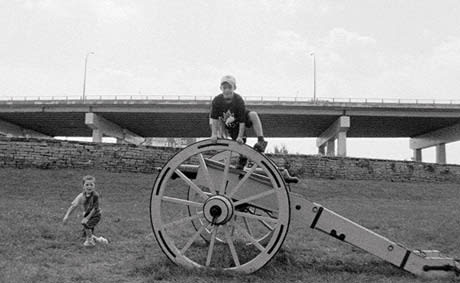All Fall Down is the experimental, poetic feature film debut from Canadian short film director and York University professor Philip Hoffman. Commissioned to do a film about a house in Southern Ontario, Hoffman uses the geography of the landscape as a jumping off point to explore stories both personal and historical.
Part of the movie focuses on George Lachlan Brown, a man slipping further and further into mental illness on the streets of Toronto, whose downward spiral is captured on phone messages left for the daughter and wife he abandoned years before, contrasted with home movie footage of the family in better times.
Another aspect of the film talks about the life of Nahneebahweequa, a 19th century aboriginal land rights activist who fought for her claim to the Grey/Bruce County land to be recognized at a time when neither female nor aboriginal land ownership was allowed. Also thrown into the mix are a lament about the decline of farming, shown through the prevalence of dilapidated barns, and some excerpts from a trite historical docudrama for which Hoffman served as cinematographer and was never paid.
The film's individual threads all have their points of interest but they never come together in a meaningful way. Pieces of the disparate tales are slowly revealed in an incoherent order throughout the film, along with a lot of lingering shots of the landscape, loaded with symbolism. Written text on the screen is used throughout as well, sometimes to illuminate the narrative but usually to add another poetic layer.
Most notably, the filmmaker keeps returning to the Wallace Stevens poem "Thirteen Ways of Looking at a Blackbird." Visually, the grainy, textured look of the film is quite beautiful, which when coupled with its minimalist sound and meandering, interwoven tangents produces a lulling, dreamlike effect.
(CFMDC)Part of the movie focuses on George Lachlan Brown, a man slipping further and further into mental illness on the streets of Toronto, whose downward spiral is captured on phone messages left for the daughter and wife he abandoned years before, contrasted with home movie footage of the family in better times.
Another aspect of the film talks about the life of Nahneebahweequa, a 19th century aboriginal land rights activist who fought for her claim to the Grey/Bruce County land to be recognized at a time when neither female nor aboriginal land ownership was allowed. Also thrown into the mix are a lament about the decline of farming, shown through the prevalence of dilapidated barns, and some excerpts from a trite historical docudrama for which Hoffman served as cinematographer and was never paid.
The film's individual threads all have their points of interest but they never come together in a meaningful way. Pieces of the disparate tales are slowly revealed in an incoherent order throughout the film, along with a lot of lingering shots of the landscape, loaded with symbolism. Written text on the screen is used throughout as well, sometimes to illuminate the narrative but usually to add another poetic layer.
Most notably, the filmmaker keeps returning to the Wallace Stevens poem "Thirteen Ways of Looking at a Blackbird." Visually, the grainy, textured look of the film is quite beautiful, which when coupled with its minimalist sound and meandering, interwoven tangents produces a lulling, dreamlike effect.
